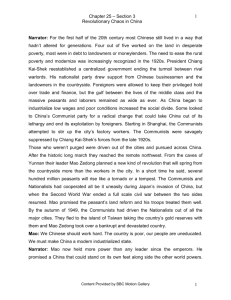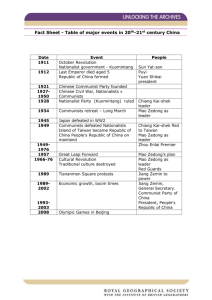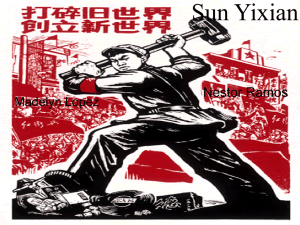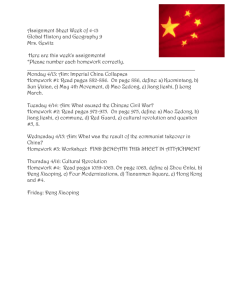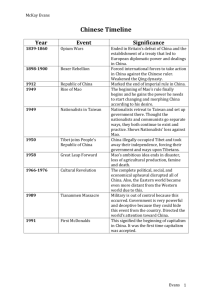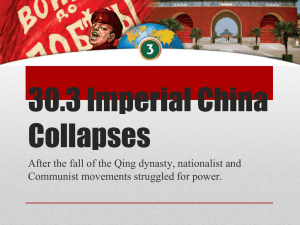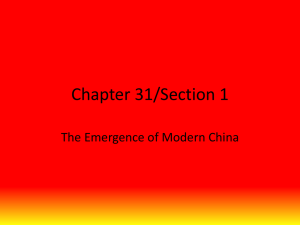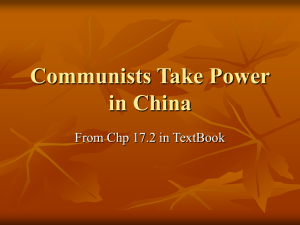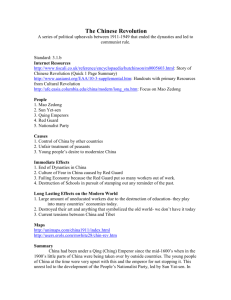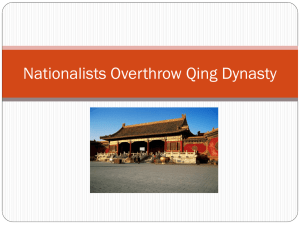Unit 4-2 powerpoint
advertisement
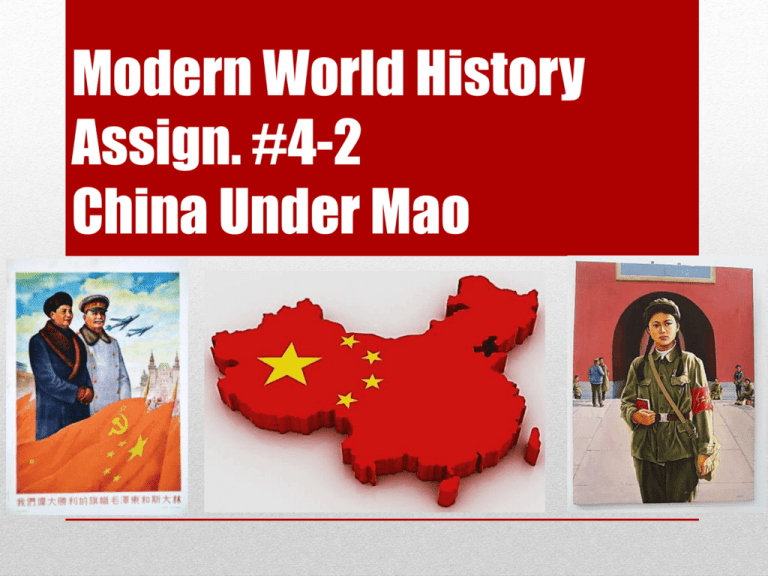
Modern World History Assign. #4-2 China Under Mao Chapter 14, Section 3 Imperial China Collapses After the fall of the Qing dynasty, nationalist and Communist movements struggled for power. China Ripe for Revolution (#1) • China faced years of humiliation at the hands of foreigners • Foreigners controlled China’s trade and resources • Many wanted to modernize, but the Qing Dynasty was not doing it • Nationalist movements that might start revolutions were the only avenue to achieving change Nationalists Overthrow Qing Dynasty (#2) • The Kuomintang (Nationalist Party) pushed for modernization and nationalization • Their first great leader was Sun Yixian • In 1911, the Revolutionary Alliance (forerunner of Kuomintang) overthrew the last emperor of the Qing dynasty Government under the Nationalists (#3) • Shaky Start for the New Republic • 1912 Sun became president of the Republic of China • “Three Principles of the People” 1. nationalism—an end to foreign control 2. people’s rights—democracy 3. people’s livelihood—economic security for all Chinese China after the Revolution (#4) • General Yuan Shikai takes over presidency after Sun steps down • Shikai betrays democratic ideals • Local revolts break out • In 1916 civil war breaks out after Shikai’s death • Provincial warlords held real authority in the provinces • World War I Spells More Problems • In 1917, the Beijing government declared war against Germany • They believed the Allies would return Chinese territories controlled by Germany to China • Instead, the Allies gave Japan those territories under Treaty of Versailles • May Fourth Movement – demonstration of students angry about the Treaty of Versailles begins in Beijing May 4, 1919 • demonstrations spread to other cities in China and were joined by workers, shopkeepers, and professionals • Sun Yixian and Kuomintang share the movement’s aims of establishing a modern, strong nation • Many Chinese intellectuals reject Sun Yixian’s belief in western democracy in favor of Soviet communism Students in Beijing rallied during the May Fourth Movement. Protestors dissatisfied with the Treaty of Versailles for China Tsinghua University students burn Japanese goods. Mao Zedong’s Brand of Communism (#5) • In 1921 a group in Shanghai (including Mao Zedong) organizes the Chinese Communist Party • Mao Zedong develops his own brand of communism • Lenin based his in the organization of Russia’s cities. • Mao brought the revolution to the rural country, with peasants as the revolutionaries The Communist Party in China • Lenin Befriends China • Sun Yixian’s government is in south China • He becomes disillusioned with Western democracies • The Kuomantang (Nationalists) allied with the Communist Party hoping to unify the Chinese people • Lenin seized the opportunity and sends military advisors and equipment to China in 1923 Two Sides Form in China (#6) Jiang Jieshi • Peasants Align with the Communists • Sun Yixian died in 1925, and Jiang Jieshi (Chiang Kai-shek) heads the Kuomantang or Nationalists • Jiang (son of a middle-class merchant) feared communist goal of forming a socialist gov ernment • Jiang promised democracy, but his government became corrupt • Peasants threw their support toward the Chinese Communist Party and Mao as he gave them land The Civil War in China • Nationalists and Communists Clash • Briefly Jiang set aside differences and fought warlords alongside the Communists, but later turned against the Communists • April 1927 Nationalists groups moved on Shanghai and killed many Communists • In 1928 Jiang became president of the Nationalist Republic of China • Great Britain and the United States recognized his government • The Soviet Union did NOT recognize his government • Civil War breaks out and lasts until 1949 Civil War Rages in China • In 1930 a bloody civil war was raging • Mao and Communists established themselves in south-central China • Mao recruited peasants into the Red Army and trained them in guerilla warfare • Nationalists attacked communists but failed to drive them out Civil War Rages in China (#7) • 1933 Jiang gathered an army of 700,000 to surround the Communist stronghold • Long March – • In a daring move, 100,000 Communist forces fled 6,000 miles on the Long March to northern China between 1934 and 1935 • Mao and survivors settle in caves in northern China • Gradually the communists gained new followers Civil War Suspended (#8) • Japan took advantage of China’s weakened situation during the civil war and invaded Manchuria, an industrial province in northeastern China • In 1937, Japan launched an allout invasion of China, and held large parts of China by 1938 • The Japanese threat forced an uneasy truce between the Jiang’s and Mao’s forces, and they united to fight the Japanese 2 Chapter 17, Section 2 Communists Take Power in China After World War II, Chinese Communists defeat Nationalist forces and two separate Chinas emerge. China in World War II • World War II in China • Mao Zedong—leads Chinese Communists against Japanese invaders, who gain supporters due to their effective guerrilla warfare tactics • Jiang Jieshi (a.k.a. Chiang Kai-shek)— leads Chinese Nationalists in WWII • Nationalists run the government during the war and face the brunt of the Japanese attacks and are weakened by this • Nationalist and Communist Chinese resume civil war after WWII ends and the Japanese leave Communists vs. Nationalists Mao Zedong Jiang Jieshi (a.k.a. Chiang Kai-shek) Civil War Ends in China (#9) • Civil War Resumes • Economic problems cause Nationalist soldiers to desert to Communists • Mao’s troops take control of China’s major cities • In 1949, the communists win and create the People’s Republic of China (PRC) • Nationalists flee to Taiwan (#10) Nationalists The Two Chinas Affect the Cold War (#9) • The Superpowers React • U.S. supports Nationalist state in Taiwan, called Republic of China • Soviets and China agree to help each other in event of attack • U.S. tries to stop Soviet expansion and spread of communism in China China Expands under the Communists (#11) • China Expands under the Communists • China takes control of Tibet and southern Mongolia • India welcomes Tibetan refugees fleeing revolt against Chinese (including the Dalai Lama) • China and India clash over border; fighting stops but tensions remain Dalai Lama Mao’s Brand of Marxist Socialism (#12) • Chinese Communists organize national government and Communist Party • Mao’s Brand of Marxist Socialism • Farming: • Mao takes property from landowners and divides it among peasants • 1 million landowners who resisted were killed • Later private land was taken and collective farms were set up with over 200 families each • Industry: • Government seizes private companies • 5-year plans set high production goals The Great Leap Forward (#13) • After success of the first Five-Year Plan, Mao proclaimed the “Great Leap Forward” program in 1958 • Collective farms were expanded into communes that supported over 25,000 people • People shared dining rooms, dormitories, and nurseries for children • No one could own private items • They were governed by strict rules • Crop failures caused a famine which killed 20 million people and the program was ended in 1961 New Policies and Mao’s Response • China and Soviet Union clash over leadership of communist movement • After the failure of the Great Leap Forward, Mao reduces his role in government • Strict socialist ideas are moderated (farm families could live in their own homes and factory workers could compete for wages and promotions) • Mao decides that the new economic policies are weakening the communist goal of social equality • Mao urged young people to revive the revolution and millions of students, and young peasants and workers joined militia units (called Red Guards) that enforced strict communism in China The Cultural Revolution (#13) • Cultural Revolution—an uprising movement led by the Red Guards to build society of peasants and workers in which all were equal • Red Guards—groups of violent and radical youth—closed schools, and executed or imprisoned many intellectuals, factory managers, professors, and others thought to be resisting • Chaos threatened farm and factory production and set China backwards • Finally in 1968, the Chinese army was ordered to imprison, execute, or exile most of the Red Guards to stop the violence and chaos The Cultural Revolution • After Mao’s death, the Gang of Four—the radical group that controlled the power organs of the Chinese Communist Party throughout the Cultural Revolution—was arrested and judged responsible for the excesses and chaos that occurred in China as a result of this revolution
